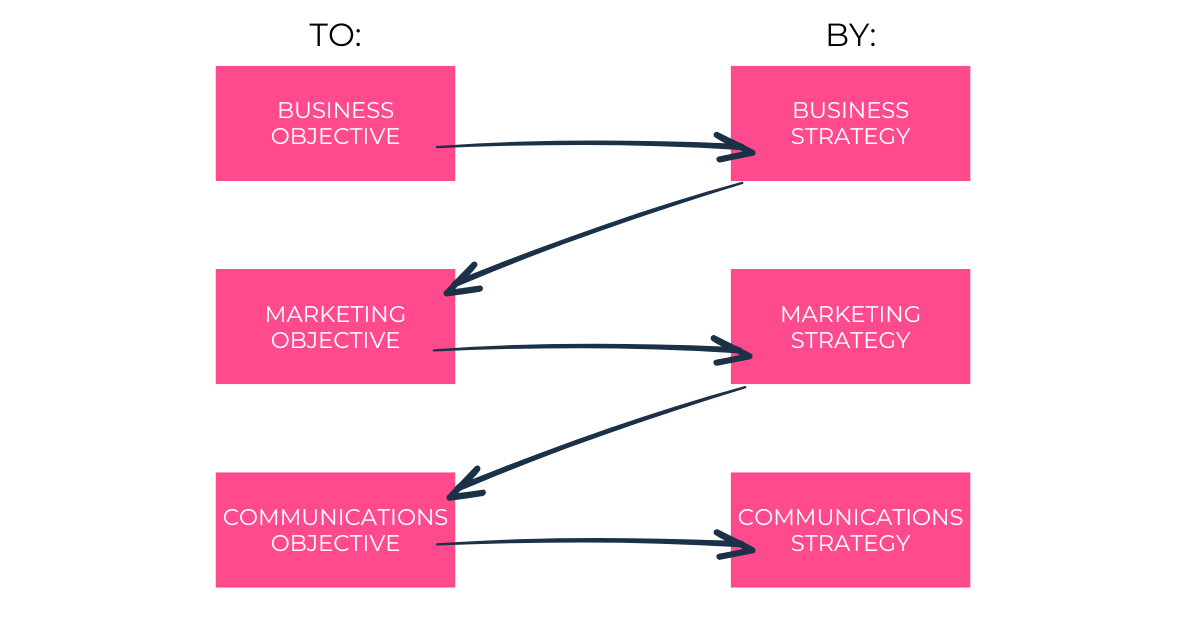Many organisations embark on bold marketing initiatives without considering how those efforts reflect wider business aims. Even when teams are brimming with creative ideas, they can struggle to maintain focus or demonstrate tangible results if they lack a unifying plan. Marketing tactics, however inventive, often fall short when pursued in isolation from the company’s broader vision.
The Cheshire Cat in Alice in Wonderland cautions, “If you do not know where you are going, any road will take you there.” This is particularly relevant in marketing, where reactive decisions and short-lived trends can consume budgets without forming a cohesive path. In contrast, strategic clarity gives purpose to every advertisement, campaign, or press release. The ‘TO-BY’ approach pairs objectives (what needs to be achieved) with strategies (how to achieve them), ensuring that every marketing effort builds on a solid foundation. Before examining how this framework operates, it is important to note that it should rest on a carefully defined business strategy.
Why a Unified Business Strategy Matters
No marketing framework can thrive if a company’s central goals remain unclear. A well-defined business strategy outlines the markets an organisation serves, how it differentiates itself, and what financial or operational milestones must be reached. These decisions determine the nature of products or services, positioning, and competitive advantages.
A cohesive marketing effort emerges from these corporate-level directives. A business might aim to expand into a new region or reposition itself to appeal to a more discerning customer base. Whatever the priority, marketing plans should align with it. When the strategy is absent or evolving, marketers risk launching campaigns in a vacuum, using time and resources without moving closer to genuine objectives.
Suppose a business wants to establish itself as a premium brand and increase annual profit by 20 percent. That high-level ambition influences every aspect of marketing, from brand messages to budget allocation. Without those guiding intentions, initiatives lose direction. The most creative projects can appear impressive yet fail to produce outcomes that sustain genuine business growth.
The Perils of Reactive Marketing
Urgent situations, such as sudden dips in sales or unexpected moves from competitors, often drive marketing teams to act spontaneously. New sales promotions or hastily conceived social media pushes might generate short-lived results, but they rarely solve deeper issues related to product viability or positioning. Continuous reaction eventually drains resources and confuses potential customers, who may receive inconsistent information about the brand.
Although an agile mindset is valuable, a constant state of reaction takes attention away from building a durable strategy. Marketing activity, no matter how frequent, is not necessarily progress. Carefully defined objectives and purposeful initiatives are more likely to attract lasting loyalty and build a coherent brand identity.
Thoughtful planning, anchored by clear objectives, creates long-term momentum. It prevents frantic responses to every minor shift in the market. This stability is especially crucial for managing budgets, since a well-planned approach typically concentrates resources on methods with proven potential, rather than scattering them on immediate but untested ideas.
Leading forces towards a definite goal:
The word “Strategy” derives from the Greek word “stratiyeia,” itself originating from stratos (army) and ago (guiding or leading). Though it was once associated with military campaigns, its essence, leading forces towards a definite goal, applies equally to modern marketing. A plan that organises resources around a clear outcome is more likely to achieve sustainable success than a plan that follows transient trends or guesswork.
This principle emphasises the importance of methodical steps designed to reach a defined end point. While chance discoveries can lead to useful breakthroughs, consistently effective marketing rarely depends on luck. It involves a deliberate allocation of budget, a structured evaluation of performance metrics, and a willingness to refine approaches that are underperforming. By returning to the original notion of leading resources, marketers can keep efforts focused and purposeful.
The ‘TO-BY’ Framework
A reliable way to implement strategy in marketing is through the ‘TO-BY’ model, which sets out objectives (“TO”) and strategies (“BY”) in three distinct tiers: Business, Marketing, and Communications. Each tier should serve as a building block for the one above it. The overall structure can be visualised in a simple grid:
The Business Objective articulates the principal goal, which might be to increase profit by 20 percent in the next year or to establish a presence in three new markets. The Business Strategy lays out how that objective will be met, whether through streamlining the supply chain or developing new product lines.
The Marketing Objective then aligns specifically with that broader ambition. If the company seeks profit growth, the marketing team may concentrate on acquiring more leads or raising average order value. The Marketing Strategy covers the tactics. For instance, the team might enhance search engine visibility, collaborate with relevant industry influencers, or host webinars that showcase expertise.
Finally, the Communications Objective defines what the organisation wants its audience to think or do. Perhaps brand perceptions need to shift from “competitively priced” to “premium and dependable.” The Communications Strategy then details the messages, media channels, and partnerships that will alter those perceptions.
The Significance of Brand Alignment
Brand consistency underpins every tier of the ‘TO-BY’ model. If an organisation sets its sights on earning recognition as a high-quality leader, every step must reinforce that identity. Communications cannot position a product as budget-friendly if the broader strategy aims to portray it as premium. Such contradictions confuse consumers and erode trust.
Clear brand objectives guide how messages evolve, ensuring that nothing conflicts with the values and identity the firm aims to represent. Visual elements, tone of voice, and the substance of promotional material should all reflect the brand’s core promise. When messages are coherent, prospective customers find it easier to believe in what is being offered.
Building Accountability and Fostering a Unified Culture
One of the key benefits of the ‘TO-BY’ approach lies in its transparency. Each objective is public, making it clear how every strategy contributes to a larger goal. Individuals at all levels can see how their work supports a defined ambition rather than pursuing isolated tasks. This clarity aids collaboration and morale. Teams recognise that their efforts add up to a meaningful impact on business performance.
Leaders should revisit objectives regularly to assess progress and decide whether to adjust their tactics. If results fall short, the framework helps pinpoint where refinements might be needed. It also encourages the practice of measuring outcomes rather than merely rating activity levels. Since each objective is paired with a strategy, success is judged by whether the activity is delivering the intended results.
This culture of accountability resonates throughout the organisation. When new hires or external agencies join, they can quickly grasp the core ambitions and understand how their role fits into the bigger picture. Teams then work cohesively, focusing on outcomes that make a real difference.
–
Successful marketing is seldom the product of improvisation. It flourishes when supported by a sound business strategy that defines what the organisation stands for, where it competes, and how it intends to grow. Once that strategy is in place, the ‘TO-BY’ framework provides a way to translate overarching ambitions into actionable plans, ensuring that each marketing initiative is both purposeful and measurable.
By pairing objectives with the strategies designed to fulfil them, marketing efforts stop being collections of isolated campaigns. They become elements of a unified push towards a well-documented goal. This structured approach helps teams avoid falling into a reactive cycle that drains resources and dilutes messages. Instead, it aligns messages and tactics across departments, strengthening the organisation’s profile in the eyes of customers and stakeholders alike.
When the path is clear, resources are channelled towards what truly matters, and brand consistency becomes second nature. In a marketplace where attention spans are short and competition is intense, clarity of purpose can be the decisive factor that propels your business forward. By making sure the marketing plan is rooted in a solid corporate strategy, and by organising it through ‘TO-BY’, companies can chart a steady course that supports sustainable growth and cultivates trust among customers. This is how a disciplined, coherent approach to marketing can help an organisation thrive.



